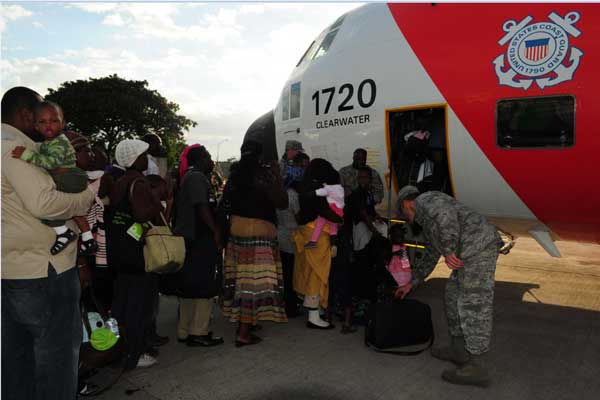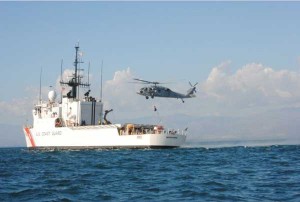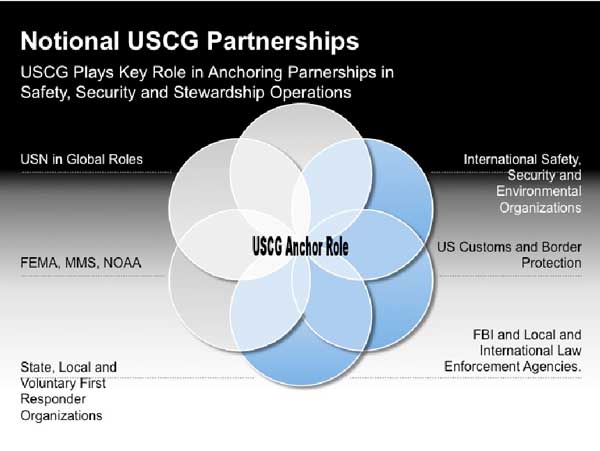An interview with Rear Admiral Branham
Commander Seventh Coast Guard District
Rear Admiral Branham has commanded the Seventh Coast Guard District for about two years; his AOR covers parts of the waters of South Carolina, all of Georgia, Florida, the Caribbean and some waters off Central America and Northern South America. He has a strong background of operational experience in going to sea and an understanding of national issues after extensive service “Inside the Beltway.”
We were especially impressed by his quick reaction to the recent Haiti Earthquake where he was the task force commander. He epitomized the Coast Guard’s philosophy of on-scene initiative by quickly moving units into place that provided the first look and assessment at the horrible damages there. The Coast Guard was first in and last out, and in fact is still there. For the first critical hours and days, they were the U.S. government’s only effective representatives given the widespread destruction.
 SLD: Your District played a key role in the Haiti Operation. Could you describe your approach and role in the crisis intervention?
SLD: Your District played a key role in the Haiti Operation. Could you describe your approach and role in the crisis intervention?
Admiral Branham: With respect to Haiti, obviously that was one of those “ah-hah!” moments that focuses the Coast Guard on a critical mission and in this case, as usual, it taxed us resource-wise. I was a Resource Director from 2005 to 2008, so I spent a number of years in that shop, and I got a perspective on that end of the resource there. Right now, I’m obviously a tactical guy and an operational guy running these programs down here.
But Haiti was just another opportunity to demonstrate the Coast Guard’s flexibility and responsiveness, in my view. And one of the reasons we can be that way is because we’re in this theater all the time down here. We live here. We work day-to-day on different missions in the region here and in this case we were able to redirect a number of key assets immediately to the task.
I’ll just run down the chronology a little bit. On the 12th of January, the earthquake hit at about ten minutes of five and within an hour I had redirected aircraft and ships to go to Port-au-Prince and help. They were very responsive. Some had to get fuel and supplies and that kind of stuff, but we had the helicopters on the ground at the Embassy the next morning at first light because they were based in the Bahamas doing Coast Guard and international missions. And we would have had them there even earlier except it was dark. I didn’t want to send them in there and put them at risk in an unfamiliar area.
SLD: If I could just insert one thing, one thing one of your staff members made a point to us during our visit to Miami, that because of the disruption of continuity of U.S. representation in Haiti because of the earthquake, you guys basically played that function as well when you inserted yourselves into Haiti.
Admiral Branham: Yes, we did. We have two senior officers based at the Embassy constantly. One is the MLO and one is the Coast Guard Liaison Officer, and that’s one of the few countries where a Coast Guard Officer is the Military Liaison Officer and works for the Combatant Commander. Because of our close working relationship with Haiti – and we’re engaged with them on a daily basis in their government, not just with respect to the Haitian Coast Guard and supporting them, but in port safety and security and in the course of the counter drug effort, and the migration effort as well, just to name a few – we helped them with aids to navigation. And we do humanitarian missions in there as well, helping out schools and hospitals and that kind of thing. So we are a frequent flyer, if you will, in Haiti, and it’s all familiar ground to us.

Admiral Branham: We’re normally there on a daily basis, and we bring the Coast Guard boats – the Haitian Coast Guard boats – back here to Miami and refurbish them and take them back down there. I routinely send the Coast Guard Cutter Oak down there, which is a 225-foot buoy tender, to train and equip and help the Haitian Coast Guard. They are 105 people, and they need our help.
And quite honestly, it’s a good investment for us because their help is essential for us to do repatriations and help to ensure that the Port-au-Prince facility is secure and safe, to help ensure security of flow back and forth, cargo back and forth, between Haiti and here, which a lot of that cargo that goes down-range that way comes out of the Miami River here.
So we were in there immediately, and I would say within three days we had ten ships and a dozen aircraft and about 700 people involved down there. As DOD phased in with what I call the heavy iron, the big ships and the large cargo aircraft and the thousands of people, we held the fort until they got there and provided a lot of basic first-aid and saved a lot of lives, providing help for people needing their essential medical care, and amputation of limbs.
We tried to help restore some order in the port so that when DOD got there, we could start working in earnest to restore the port. The airport was basically unusable because there was no air control – the tower had been knocked out. Two of our ships in succession provided air control capability until DOD could get temporary facilities there and restore that.
We hauled a lot of American citizens out of there on our fixed-wing aircraft back to safety and medical care on the order of about 1,500 in the first three days. We brought urban search and rescue teams down there from CONUS (Continental United States), a couple of them here in Miami, and all kinds of relief supplies.
So I think if you could characterize it, we were the 911 force for the first three or four days, and we’re still there, even after most of the DOD goes home. But we phased in and dovetailed in with the DOD and augmented their force, and we did some things they can’t necessarily do and vice-versa, so it was a great team, along with all the other agencies like State, Justice, Health and Human Services, and DOD.

SLD: Well one of the things I don’t think is fully recognized outside of the Coast Guard is that people see that 911 functionality. What they don’t see is when everybody else has left, you’re still operating in the Caribbean dealing with a lot of the follow-on consequences from Haiti, whether it be immigration management, or disaster relief, or whatever, and that ties up a reasonable amount of your resources.
Admiral Branham: Yeah it does. In fact we dedicate significant resources each and every day to countering potential migration flow out of several countries here, but in this case, Haiti. And we have a force down there now that’s patrolling, making sure they’re visible. And in fact, that is what I call a normal flow out of that country that is pretty much invisible to the average American. That there’s a normal flow out of there on any given day and we’re interdicting Haitian migrants. We get spikes every once in awhile and sometimes we get a mass exodus, but we’re there every day.
Now there’s an opportunity cost. When we divert those kinds of resources from their current missions to a contingency operation like Haiti, obviously there’s an opportunity cost to pay, and we pulled on the order of four ships from joint task force south, which is focused on counter drug detection and monitoring. Of course, we run the end game here with the Coast Guard doing the interdictions, but we pulled the Coast Guard Cutter Hamilton from the Eastern Pacific, and at least two, maybe three, what we call major cutters from the Caribbean area, from Joint Interagency Task Force South, to work specifically for the 7th District and the taskforce – Homeland Security Task Force – to focus on the Haiti mission. So to some degree the door is open for bad guys to exploit that situation of resource diversion.
SLD: One of the missing metrics from the USCG budget is the recapitalization costs of discretionary operations like Haiti. You go to Haiti, accelerate the life cycle utilization of your assets, and there are no replacement costs put into the budget kitty to accompany costs for increased or additional operation tempo.
Admiral Branham: What we call “fully-loaded costs;” they tend to use up useful service life at accelerated pace, obviously, when you’re running these kinds of operations. And there’s a price to be paid, as you say, and it’s not reflected in the recapitalization plan. And you’re right: we are chewing up resources and not replacing them quick enough.
SLD: Another issue I find of interest is the core role, which the USCG plays as the central partner for agencies in such crises like Haiti or the Gulf oil spill. If we were to draw up a Venn diagram with the USCG as the center of the diagram and map out the other agencies playing a role, those agencies expect the USCG to show up with resources. What I do not see is the budget built around paying the USCG to have those resources able to be in place and “rented out” to shape a partnership coalition performance.
 Admiral Branham: I can tell you from my own experience here in Miami from sharing or directing this task force, that I have a unified command that surrounds me in that role. It’s made up of representatives from a number of DHS agencies, regional chiefs down here, and some folks from the State of Florida, and a couple of other representatives. And they look to the Coast Guard to be the center of that Venn diagram, if you will. We bring, such as it is, the most robust capability. We also bring, I think, leadership that they look to focus on as well, to rally around. And it’s flattering, but it’s true, they view the Coast Guard as the driving force between conducting these operations and these programs so it would be worth exploring the challenge of getting funded for playing that role.
Admiral Branham: I can tell you from my own experience here in Miami from sharing or directing this task force, that I have a unified command that surrounds me in that role. It’s made up of representatives from a number of DHS agencies, regional chiefs down here, and some folks from the State of Florida, and a couple of other representatives. And they look to the Coast Guard to be the center of that Venn diagram, if you will. We bring, such as it is, the most robust capability. We also bring, I think, leadership that they look to focus on as well, to rally around. And it’s flattering, but it’s true, they view the Coast Guard as the driving force between conducting these operations and these programs so it would be worth exploring the challenge of getting funded for playing that role.
Again, I think the viewpoint of those folks that are our partners – and I can give you a list as long as your arm that we haven’t talked about here – it would also be interesting to see what their viewpoint is about their own resourcing because particularly the DHS partners have their own requirements, which they need to further. And so at some point they’ll be reluctant to rally around the Coast Guard resources.
SLD: From your experience in your district, what investments in the near term would you like to see plused up?
Admiral Branham: Well a couple of things. One of the big payoff items is command and control and interagency command centers where we can actually pull together a group in a region. Right now we’ve got one up in Charleston. That’s an excellent facility and does great things in pulling together command and control and daily operations across the interagency and state partners. And for the lack of a little bit of bricks and mortar money, we’re not able to pull those types of things together where they need to be. And that’s something that if I were to invest money at this point, it would be in interagency command and control centers that truly get at what the department was established for, which is to consolidate operations and to share information and intelligence and reduce overhead.
The other area that I’d invest money in is exactly in what we’re doing right now: recapitalizing our ships and at this point focusing heavily on replacing our patrol boats. I’ve run about 25 patrol boats in this district, which is about 25 percent of what the Coast Guard has, and they are falling apart. And they’re the backbone of us getting our mission done down here, with respect to counter drug and migrant operations. So if I were to invest money, that’s exactly where I’d put it. And in that response boat medium as well, which is the future backbone of our search and rescue capability in the coastal regions.
———-
***Posted June 8th, 2010

